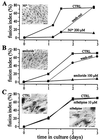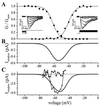T-type alpha 1H Ca2+ channels are involved in Ca2+ signaling during terminal differentiation (fusion) of human myoblasts
- PMID: 10861024
- PMCID: PMC16596
- DOI: 10.1073/pnas.97.13.7627
T-type alpha 1H Ca2+ channels are involved in Ca2+ signaling during terminal differentiation (fusion) of human myoblasts
Abstract
Mechanisms underlying Ca(2+) signaling during human myoblast terminal differentiation were studied using cell cultures. We found that T-type Ca(2+) channels (T-channels) are expressed in myoblasts just before fusion. Their inhibition by amiloride or Ni(2+) suppresses fusion and prevents an intracellular Ca(2+) concentration increase normally observed at the onset of fusion. The use of antisense oligonucleotides indicates that the functional T-channels are formed by alpha1H subunits. At hyperpolarized potentials, these channels allow a window current sufficient to increase [Ca(2+)](i). As hyperpolarization is a prerequisite to myoblast fusion, we conclude that the Ca(2+) signal required for fusion is produced when the resting potential enters the T-channel window. A similar mechanism could operate in other cell types of which differentiation implicates membrane hyperpolarization.
Figures







References
-
- Shainberg A, Yagil G, Yaffe D. Exp Cell Res. 1969;58:163–167. - PubMed
-
- Przybylski R J, MacBride R G, Kirby A C. In Vitro Cell Dev Biol. 1989;25:830–838. - PubMed
-
- Przybylski R J, Szigeti V, Davidheiser S, Kirby A C. Cell Calcium. 1994;15:132–142. - PubMed
-
- David J D, See W M, Higginbotham C A. Dev Biol. 1981;82:297–307. - PubMed
Publication types
MeSH terms
Substances
LinkOut - more resources
Full Text Sources
Other Literature Sources
Molecular Biology Databases
Research Materials
Miscellaneous

